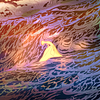You need to sign in or sign up before continuing.
Take a photo of a barcode or cover
More of a straightfoward adventure story than Le Guin’s later works, but the strong philosophical and antropological interest are already here, as is the poetic language and the condensed, almost fable-like form of the story.
adventurous
lighthearted
reflective
relaxing
fast-paced
Plot or Character Driven:
A mix
Strong character development:
No
Loveable characters:
Yes
Diverse cast of characters:
Yes
Flaws of characters a main focus:
No
An action-packed gem of a novel that combines fantasy and sci-fi. Le Guin creates a strange new world on the planet of Fomalhaut II, peopled by different species and unique societies. With its feudal systems, castles, lords and ladies, and flying cat-like steeds, it is reminiscent of the pre-industrial medieval-like settings of fantasy novels. But on this planet is Gaveral Rocannon, an ethnologist stranded by himself after being sent out to survey the planet for the League - the interplanetary federation of planets including Earth. Rocannon learns that the League’s enemies, rebels from Faraday, are invading and plan to hide out on this distant primitive planet far from the League’s eyes, so he joins forces with a young lord, Mogien, and his entourage including a bard, Yahan, on a quest to locate the rebel base and use their transmitter to tell the League of the Faradayans’ location. On their way, they face various challenges and hostile forces, including other races and kingdoms. This was Le Guin’s first book in 1966, marked by her trademark ability to create vividly drawn new worlds and alternative societies. It has a tautness of prose that crams in as much storytelling as more recent fantasy writers fit into four or five times as many pages.
The kind of book the sole purpose of which seems to be to entertain.
I was impressed enough by The Left Hand of Darkness that I decided to read the whole series from the beginning, and I was lucky enough to find some lovely 1980 mini-format editions of the first few, so this is the second of hers I've read.
It's Le Guin's first novel, but her vision is strikingly well-formed, with canonical details of the Hainish universe being pretty consistent with the later book.
The story blends sci-fi and fantasy elements very successfully and is concisely and enjoyably told. While there are too many long and flabby books out there, this is a rare example of one that I'd criticise for being *too* brisk. I hope later episodes give the story and characters more space.
It's Le Guin's first novel, but her vision is strikingly well-formed, with canonical details of the Hainish universe being pretty consistent with the later book.
The story blends sci-fi and fantasy elements very successfully and is concisely and enjoyably told. While there are too many long and flabby books out there, this is a rare example of one that I'd criticise for being *too* brisk. I hope later episodes give the story and characters more space.
Loved this retro scifi book and the winged cats it flew in on.
…the man… was trapped in his own cruelty: the jailer is the
prisoner’s prisoner.
I’ve read two of the later Hainish Cycle novels—The Left Hand of Darkness and The Dispossessed—and I don’t think this one measures up. Partly that’s because I personally prefer sci-fi over fantasy, and stylistically this is very much a fantasy novel, even if it involves spaceships. But it also lacks any particularly thought-provoking elements. Perhaps the most unique idea in it (which only plays a very minor role) is the culture which has telepathic, communal memory but only remembers happy things.
Enjoyable, not memorable.
(crosspost)
slow-paced
Plot or Character Driven:
A mix
Strong character development:
Yes
Loveable characters:
No
Diverse cast of characters:
Yes
Flaws of characters a main focus:
Complicated



